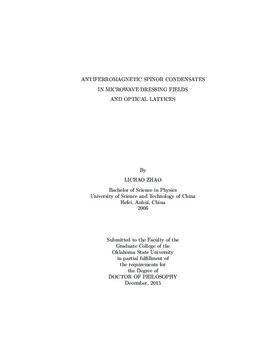| dc.contributor.advisor | Liu, Yingmei | |
| dc.contributor.author | Zhao, Lichao | |
| dc.date.accessioned | 2017-02-22T22:11:47Z | |
| dc.date.available | 2017-02-22T22:11:47Z | |
| dc.date.issued | 2015-12 | |
| dc.identifier.uri | https://hdl.handle.net/11244/48931 | |
| dc.description.abstract | In this thesis, I present the design and construction of several experimental parts, e.g., a spin-flip Zeeman slower, a fast feedback circuit, and some magnetic field driving circuits. An efficient method of optimizing the slower with our simulation program is explained. I also demonstrate how the efficiency of a slower strongly depends on a few of its intrinsic parameters, such as the intensity of the slowing laser beam and the length of each section in the slower. These findings lead to a simple three-step procedure of designing an optimal Zeeman slower for neutral atoms, especially for those atomic species with high initial velocities, for example lithium atoms. | |
| dc.description.abstract | In addition, we experimentally study spin dynamics of a sodium antiferromagnetic spinor condensate as a result of spin-dependent interactions c and microwave dressing field interactions characterized by the net quadratic Zeeman effect qnet. In contrast to magnetic fields, microwave dressing fields enable us to access both negative and positive values of qnet. We find an experimental signature to determine the sign of qnet, and observe harmonic spin population oscillations at every qnet except near each separatrix in phase space where spin oscillation period diverges. No spin domains and spatial modes are observed in our system. Our data in the negative qnet region exactly resembles what is predicted to occur in a ferromagnetic spinor condensate in the positive qnet region. This observation agrees with an important prediction derived from the mean-field theory: spin dynamics in spin-1 condensates substantially depends on the sign of qnet/c. This work may be the first to use only one atomic species to reveal mean-field spin dynamics, especially the remarkably different relationship between each separatrix and the magnetization, of spin-1 antiferromagnetic and ferromagnetic spinor condensates. | |
| dc.format | application/pdf | |
| dc.language | en_US | |
| dc.rights | Copyright is held by the author who has granted the Oklahoma State University Library the non-exclusive right to share this material in its institutional repository. Contact Digital Library Services at lib-dls@okstate.edu or 405-744-9161 for the permission policy on the use, reproduction or distribution of this material. | |
| dc.title | Antiferromagnetic spinor condensates in microwave dressing fields and optical lattices | |
| dc.contributor.committeeMember | Mintmire, John W. | |
| dc.contributor.committeeMember | Summy, Gil S. | |
| dc.contributor.committeeMember | Zhang, Weili | |
| osu.filename | Zhao_okstate_0664D_14382.pdf | |
| osu.accesstype | Open Access | |
| dc.type.genre | Dissertation | |
| dc.type.material | Text | |
| thesis.degree.discipline | Physics | |
| thesis.degree.grantor | Oklahoma State University | |
